Kanimbla / Kurra-Ba and Kosciusko
Kanimbla (later Kurra-Ba) and Kosciusko were two similar "K-class" ferries on Sydney Harbour. Launched in 1910 and 1911 respectively, the two timber-hulled steamers were built for Sydney Ferries Limited during the boom in cross-harbour ferry travel prior to the opening of the Sydney Harbour Bridge.
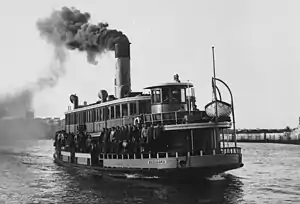 Kosciusko as a steamer approaches Circular Quay | |
| History | |
|---|---|
| Name: | Kanimbla (later Kurra-Ba), Kosciusko |
| Operator: | |
| Builder: | Morrison & Sinclair (Kanimbla), David Drake (Kosciusko) |
| Launched: | 1910 (Kanimbla) & 1911 (Kosciusko) |
| Out of service: | 1940s (Kanimbla), 1975 (Kosciusko) |
| Fate: | Kanimbla broken up 1950s, Kosciusko burnt out 1986 in Hobart |
| General characteristics | |
| Tonnage: | 156 (Kanimbla), 165 (Kosciusko) |
| Length: | both 34.1m |
| Speed: | 11 knots (Kanimbla), 10 knots (Kosciusko) |
| Capacity: | 790 passengers approx. |
Kanimbla was renamed "Kurra-Ba" in 1935, laid up in the 1940s and broken up in the 1950s. Kosciusko was converted to diesel propulsion in the 1950s and served on Sydney Harbour until 1975 when she was sent to Hobart to assist following the collapse of the Tasman bridge. She was burnt out in 1982.
Background
Both ferries were built for Sydney Ferries Limited during the early twentieth century boom in cross-Harbour travel prior to the 1932 opening of the Sydney Harbour Bridge. At the time, the company ran one of the largest ferry fleets in the world. The two ferries were part of broader type of around 20 double-ended timber screw ferries the Sydney K-class ferries that the company commissioned between the 1890s and early 1920s to meet the booming demand.
Kanimbla followed the Sydney Ferries Limited tradition of naming their vessels after Australian Aboriginal words starting with "K". "Kanimbla" is thought to mean "big fight". Kosciusko was named after the Australian mountain which was, in turn, named after Polish military leader Tadeusz Kościuszko.
Design and construction
Kanimbla was built in 1910 by Morrison & Sinclair, of Balmain. Her 55 hp triple expansion steam engine was supplied by Mort's Dock & Engineering Co and pushed her to 11 knots. The timber ferry was 156 tons, 35.4 m in length, and had a passenger capacity of 791.
Although delivered by a different builder, Kosciusko was very similar to Kanimbla in form and size. She was built in 1911 (the year following Kanimbla) by David Drake, of Balmain. Her 54 hp triple expansion steam engine was supplied by Campbell & Calderwell and pushed her to 10 knots. Also a timber-built vessel, she was 165 tons, 35.4 m and had a passenger capacity of 785.
Service history
Both ferries survived the 1932 opening of the Sydney Harbour Bridge, after which demand for ferries dropped significantly and much of the fleet was laid up. Kanimbla gave up her original name in 1935 to a new larger Royal Australian Navy ship, HMAS Kanimbla, and became Kurra-Ba (not to be confused with the "Kurraba" a Sydney ferry laid up in 1932). Kurra-Ba was pulled out of service and laid up around 1946, and was broken up in the 1950s along with a number of other larger K-class steamers as part of a fleet rationalisation following the NSW State Government's Sydney Harbour Transport Board takeover of the struggling Sydney Ferries Limited.
Kosciusko was one of the few formerly numerous K-class ferries to survive both the 1932 opening of the Sydney Harbour Bridge and the 1950s state government rationalisation of the fleet. Kanangra, Karingal, Karrabee, and Kameruka were also kept in service and converted from steam to diesel propulsion in the 1930s and 1950s. Kosciusko was converted to diesel in 1959 (60 hp Crossley, 11 knots) which allowed coal-fired Kareela to be retired. When first commissioned, she was a medium size ferry in comparison to the rest of the Sydney Ferries fleet, however, by the 1970s, she was the second largest.
In 1975, Hobart's north-south link was cut by the Tasman Bridge disaster. Alternatives were urgently needed, and Sydney's then new Lady Wakehurst was sent to the Tasmanian city to assist with cross-Derwent travel. Lady Ferguson and Kosciusko were towed to Hobart soon after, however, the timber 1914-built Lady Ferguson was too poor condition to be used. Kosciusko was sold to the city and following re-opening of the bridge, she was again sold and used as a floating restaurant. During renovations in 1982, she caught fire and was burnt out. Her stern, including the propeller and rudder, are displayed outside a hotel in Hobart.
Incidents
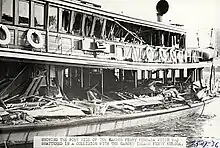
- Early in her service life, Kosciusko is rammed by a steel fuel barge under tow, causing her severe damage. She doesn't sink only because the barge could not be easily removed and is sealing the hole in her hull.
- September 1924, Kosciusko collides with Kurraba in Neutral Bay. Kurraba is significantly damaged with bulwarks ripped away and her cabin bulwark smashed. Damage to Kosciusko was light in comparison. Both ferries were carrying large amounts of passengers, but there were no injuries.[1]
- 11 August 1926 - Kanimbla collides with Manly ferry, Binngarra near Kirribilli Point. The steel Binngarra is not significantly damaged, however, she cuts deep into timber Kanimbla.[2]
- 5 May 1927, the steel Manly ferry Balgowlah collides with Kanimbla at Circular Quay tearing a hole in the Kanimbla's port bow. 100 passengers are transferred to the ferry Kookooburra.[3] Balgowlah had minor damage whereas timber Kanimbla nearly sank and four of her passengers were injured.
- 28 July 1933, Kosciusko runs aground at Kirribilli Point near Admiralty House while travelling to Neutral Bay in thick winter fog. The stock and pintle of the rudder were broken disabling steering at one end of the ferry.[4]
- 23 September 1936 - Kurra-ba collides with ferry Kulgoa causing significant damage to her superstructure.
- August 1937, Kosciusko collides head on with ferry Kiamala causing significant damage to both vessels.[5]
Kanimbla / Kurra-Ba
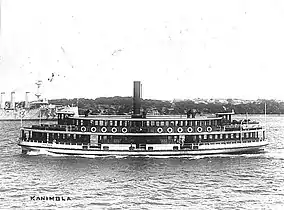 Kanimbla, as built
Kanimbla, as built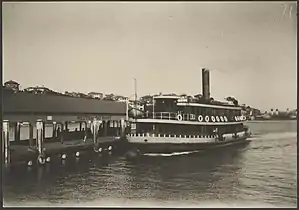 Kanimbla, in her original livery, approaches Neutral Bay wharf, 1930
Kanimbla, in her original livery, approaches Neutral Bay wharf, 1930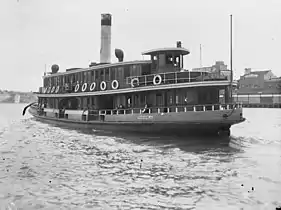 Kanimbla approaches Circular Quay, 1934
Kanimbla approaches Circular Quay, 1934
Kosciusko
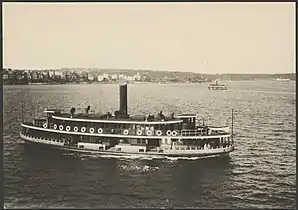 Kosciusko as a steamer and in her original varnished timber, white trim, and black funnel livery, 1920s.
Kosciusko as a steamer and in her original varnished timber, white trim, and black funnel livery, 1920s.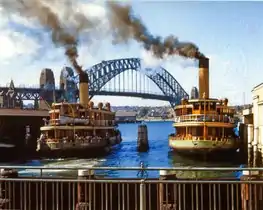 Kosciusko (left) as a steamer alongside Kubu (right) at Circular Quay in their post mid 1930s yellow and green livery, 1956
Kosciusko (left) as a steamer alongside Kubu (right) at Circular Quay in their post mid 1930s yellow and green livery, 1956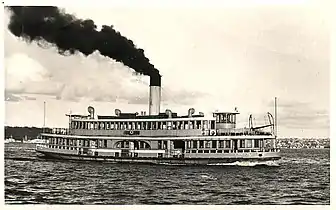 Kosciusko on the Taronga Zoo run 1955
Kosciusko on the Taronga Zoo run 1955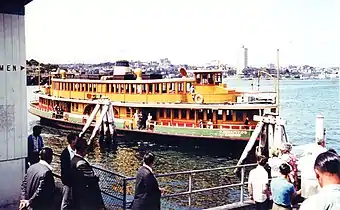 Approaching Darling Street Wharf (East Balmain Wharf) in the 1960s following her conversion to diesel
Approaching Darling Street Wharf (East Balmain Wharf) in the 1960s following her conversion to diesel Kosciusko off Cremorne Point as a diesel vessel, 1973
Kosciusko off Cremorne Point as a diesel vessel, 1973 Kosciusko on Woodleys slip for maintenance, August 1973
Kosciusko on Woodleys slip for maintenance, August 1973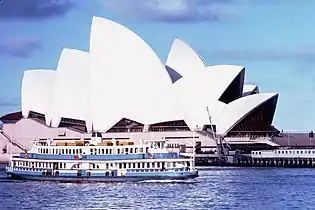 Kosciusko passing the newly opened Sydney Opera House in Public Transport Commission colours, 25 Oct 1973
Kosciusko passing the newly opened Sydney Opera House in Public Transport Commission colours, 25 Oct 1973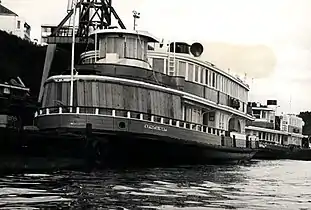 Kosciusko boarded up ready for the tow to Hobart following the collapse of the Tasman Bridge, 1975
Kosciusko boarded up ready for the tow to Hobart following the collapse of the Tasman Bridge, 1975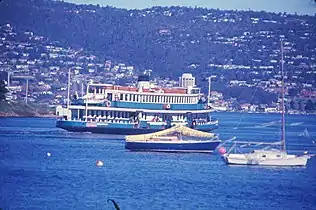 Kosciusko in Hobart to assist following the collapse of the Tasman Bridge
Kosciusko in Hobart to assist following the collapse of the Tasman Bridge
References
- "Collision of Ferry Steamers". Northern Star. 49. New South Wales, Australia. 12 September 1924. p. 4. Retrieved 29 December 2020 – via National Library of Australia.
- "Harbor Sensation". National Advocate. New South Wales, Australia. 11 August 1926. p. 2. Retrieved 29 December 2020 – via National Library of Australia.
- "Ferry Smashes Have Been Frequent". The Evening News (18835). New South Wales, Australia. 4 November 1927. p. 15. Retrieved 14 November 2020 – via National Library of Australia.
- "Ferry Steamer Aground". The West Australian. XLIX (9, 698). Western Australia. 29 July 1933. p. 15. Retrieved 29 December 2020 – via National Library of Australia.
- "Ferries Collide in Sydney Harbour". The Argus (Melbourne). Victoria, Australia. 12 August 1937. p. 9. Retrieved 4 January 2020 – via Trove.
- Andrews, Graeme (1975). The Ferries of Sydney. A.H. & A.W. Reed Pty Ltd. p. 29. ISBN 0589071726.
- Andrews, Graeme (1982). A Pictorial History of Ferries: Sydney and Surrounding Waterways. Sydney: AH & AW Reed Pty Ltd. ISBN 0589503863.
- Gunter, John (1978). Across the harbour : the story of Sydney's ferries. Rigby. ISBN 0727007157.
- Prescott, A M (1984). Sydney Ferry Fleets. Magill, South Australia: Ronald H Parsons. ISBN 0-909418-30-6.
External links
 Media related to Kanimbla (ship, 1910) at Wikimedia Commons
Media related to Kanimbla (ship, 1910) at Wikimedia Commons Media related to Kosciusko at Wikimedia Commons
Media related to Kosciusko at Wikimedia Commons